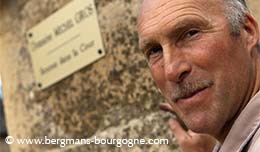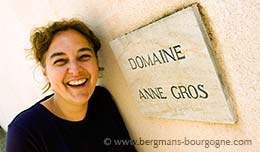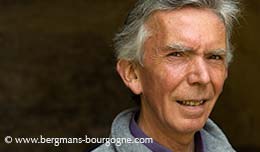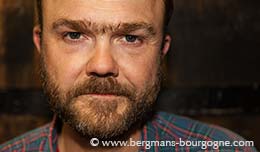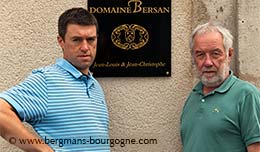
los Salomon has been in the same family for centuries. It is both the name of the domaine and the name of the main vineyard, the 6.98 hectare premier cru in Givry. When Ludovic du Gardin talks about the history of his domaine one generation all of a sudden seems like a short period of time.
 – The clos takes its name from the Salomon family, he explains. During the 14th and 15th centuries they delivered wine to the Avignon popes. Around 1520-1530 we lose track of this family. Then in 1558 my family took on the domaine.
– The clos takes its name from the Salomon family, he explains. During the 14th and 15th centuries they delivered wine to the Avignon popes. Around 1520-1530 we lose track of this family. Then in 1558 my family took on the domaine.
Givry, located between Mercurey and Montagny in the Côte Chalonnaise, is a village with some 3700 inhabitants. The production of red wine dominates, with about 85 per cent.
– The Clos Salomon has always been a monopole, always one single owner, says Ludovic du Gardin. The Salomon family had vines all over Givry, but the Clos Salomon remained in the family in one piece.
 Clos Salomon is right next to the winery, above Les Grands Prétans and south of Les Bois Chevaux. Part of the wall surrounding it has been gone since World War II, when 200 metres of it were destroyed.
Clos Salomon is right next to the winery, above Les Grands Prétans and south of Les Bois Chevaux. Part of the wall surrounding it has been gone since World War II, when 200 metres of it were destroyed.
– We are not winegrowers from father to son since way back. My father was a winegrower. Before him it was my great uncle. But before that there were three winegrowers living here. Our family were the owners, but not the ones making the wine.
– It seems that the clos always has been planted with pinot noir. In the archives there are some traces of white wine production, but we are not sure it is from the clos. There has been other vineyards in the family, so it may very well have come from there.
Clos Salomon benefits from a south-east exposure. The vineyard lies at an altitude of between 240 and 274 metres above sea level. According to Ludovic du Gardin there are three different soil types inside the clos.
 – The main part is colluvial deposits derived from limestone originating from the small valley above Clos Salomon, he says. There is one part next to the house which is more the same style as Les Grands Prétans just below. There is one part at the top, where the soil doesn’t come from the valley, where there is more clay.
– The main part is colluvial deposits derived from limestone originating from the small valley above Clos Salomon, he says. There is one part next to the house which is more the same style as Les Grands Prétans just below. There is one part at the top, where the soil doesn’t come from the valley, where there is more clay.
– Givry is on Oxfordian limestone, which is the same as in Volnay. That is why you often see comparisons between the wines from the two villages.
Ludovic du Gardin believes the average age of the vines in Clos Salomon is 40 to 50 years. The family archives tells us a lot about the work done by previous generations, especially about harvest dates, yields, etc. Less so about replanting vines. Many vines have been replaced one by one as old ones have died.
 – My father took on the domaine in the 1960’s. But he was killed in a tractor accident 1977. My mother then took on the domaine, together with different chefs de culture. Fabrice Perrotta arrived here in 1990. In 1997 he stepped in as partner together with me.
– My father took on the domaine in the 1960’s. But he was killed in a tractor accident 1977. My mother then took on the domaine, together with different chefs de culture. Fabrice Perrotta arrived here in 1990. In 1997 he stepped in as partner together with me.
Together they started changing things at the domaine, a process which lasted for a decade.
– We had a look at everything, explains Ludovic du Gardin. Vinification, harvest, etc. For instance, before we had barrels that were as old as 20 years. Now there is a maximum of three or four years. We changed how we bring in the harvest. We only use small 10 kg cases.
 – I believe the terroir should express itself. We don’t try to give the wine a certain style. That is why the work in the vineyard is so important. But the pinot noir should not be too ripe or you will risk having a jammy wine. And you should not use too much new oak either.
– I believe the terroir should express itself. We don’t try to give the wine a certain style. That is why the work in the vineyard is so important. But the pinot noir should not be too ripe or you will risk having a jammy wine. And you should not use too much new oak either.
Just before bottling there is a very light filtration. Ludovic du Gardin says it makes the wine a bit more accessible when young.
– No matter which vintage you taste of Clos Salomon there is always the same fruit. I would say cherries, others use different red fruits to describe it. There is always a very nice acidity in this wine. Even in ripe vintages, low on pH, it is still there. Thanks to this the wine has a very good aging potential.
 Ludovic du Gardin sees two different explanations to this acidity. It could be the character of the soil itself that is the origin. But it could also be due to the fact that the Côte Chalonnaise was a poor part of Burgundy during the 1960’s, which prevented the growers from using chemicals in the vineyards.
Ludovic du Gardin sees two different explanations to this acidity. It could be the character of the soil itself that is the origin. But it could also be due to the fact that the Côte Chalonnaise was a poor part of Burgundy during the 1960’s, which prevented the growers from using chemicals in the vineyards.
– In the Côte de Beaune and in the Côte de Nuits the growers could afford it. Here, in the Côte Chalonnaise, it was almost a potassium deficiency.
In recent years there has been two additions to the vineyard portfolio, both chardonnay vineyards. 2003 was the first vintage from a tiny parcel – 0.41 ha – of Givry blanc. The year after a parcel in Montagny – 2.19 ha – followed.
– My maternal grandfather had 10–15 hectares in Montagny. He sold most of it and only kept a couple of hectares. When his domaine later was sold we took on the vineyard.
The Montagny parcel, Le Clou, is straddling the border between Montagny and Saint-Vallerin. The part in Montagny is Montagny premier cru, while the Saint-Vallerin part is Montagny village. All is vinified together and sold as village wine.
– For the Montagny we work one hundred per cent with barrels, says Ludovic du Gardin. Most Montagnys are made in tank. But we don’t use much new oak. Just 10–20 per cent. Otherwise the wine would become too heavy. This is a terroir that doesn’t take new oak very well.
– The white Givry comes from a parcel in La Grande Berge. It’s the highest point in Givry. The land comes from a friend, but we planted it. It is very calcareous. The annual production is just 2000–2500 bottles.
© 2016 Ola Bergman










